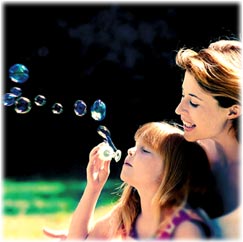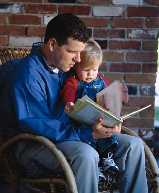Tips for Child Development
 First and foremost, children get “hooked” on listening to language, and they also learn valuable skills. Children learn the patterns and rhythms of their language, how words can be put together in a fun musical way.Patterns are very important for early reading and for math. Reading specialists have advised that a child’s ability to discriminate and create rhyming words, as well as their internal sense of rhythm,are closely related to early reading ability. A child who has absorbed over and over through the ears and not the eyes – such common rhymes as “fun, sun, run” or “fiddle, diddle, middle” as well as the melody of their language, is statistically destined to have an easier time learning to read.
First and foremost, children get “hooked” on listening to language, and they also learn valuable skills. Children learn the patterns and rhythms of their language, how words can be put together in a fun musical way.Patterns are very important for early reading and for math. Reading specialists have advised that a child’s ability to discriminate and create rhyming words, as well as their internal sense of rhythm,are closely related to early reading ability. A child who has absorbed over and over through the ears and not the eyes – such common rhymes as “fun, sun, run” or “fiddle, diddle, middle” as well as the melody of their language, is statistically destined to have an easier time learning to read.
In the same way, songs incorporating rhythm are an important teaching tool. Even before they are born, babies are comforted by the rhythms of their mothers’ bodies. After birth, rhythm continues to be a comfort. Early in life infants learn to respond to music by moving their bodies and swaying. Later they imitate rhythms and sounds. Through music activities, children learn important pre-language skills naturally – listening, paying attention and concentrating – which lead to anticipating what comes next and being able to follow directions. All of these things form the foundation for learning conventional communication. Singing songs together also involves physical contact, repetition, turn-taking, non-verbal responses, vocal play, actions and an awareness of the appropriate timing for action and/or words. The rhythm and melody of a song help a child to anticipate and recognize when it’s his or her turn. This “timing” is a very important conversational skill.
But nursery rhymes and songs aren’t just for the development of speech and reading, they are also excellent for strengthening emotional and intellectual development. The bond between caregiver and child is enhanced, there is practice with language, listening and memory, there is pleasure in the auditory stimulation and there’s lots of enthusiasm and fun! So let’s turn off the radio, TV, tape recorder, computer and the VCR and let’s turn on our children by helping them become active participants with us in songs and rhymes.
What is INTERACTIVE READING?
 Interactive Reading is when you involve your child in the reading process even if they have not begun to read on their own.
Interactive Reading is when you involve your child in the reading process even if they have not begun to read on their own.
How can this be done?
Reading to your child is the Number 1 requirement to help your child become a successful reader. By reading to you child, you will bestow upon them, the love of literacy, a gift of loving to read, which is a gift of a lifetime. Interactive Reading is when you have them participate in the reading process by involving all the senses of see, hear, say and do and even touch.
When children are as young as 6 months to 4 years old, you can choose “fabric type of books” where they can touch and feel the pages and characters as you read to or with them. When reading with or to children of all ages follow some simple guidelines:
- Stop every now and then and ask them questions to see if they are listening and understanding the story.
- Enjoy every page of the book, looking at pictures if any and talking about What if and Why situations.
- Stop in the middle of sentences with because… and see if they can predict what happens. Encourage critical thinking and creative thinking.
- Place your finger under the text so that your child begins to understand that reading is from left to right and this is helpful if your child is dyslexic or suffers from any attention deficit disorders. It helps them keep track with the story and helps them read along and begin to follow the left to right order.
- Re-read books to your child, choosing large texts for little children so they begin to recognize and follow the stories and begin to try reading.
- Pretend to play or be the characters in the story.
- Ask questions that teach important life lessons such as. Should Red Riding Hood have talked to the Big Bad Wolf, why or why not? Was it right for Goldilocks to go into a house of strangers?
- Using rhyming books such as Dr. Seuss are great for easy reading and language development since rhymes are easy to remember and follow.
SEE, HEAR, SAY AND DO… AND SEE THE DIFFERENCE IN YOUR CHILD
Your child has 5 main pathways into their brain and they learn by see, hear, touch, taste and smell. If you can help your child develop these 5 acute senses, you will lay the foundation and basis for a better learning. The first 6 years are critical in development since this is when science has proven the brain soaks up information. The more effective the stimulation you provide to your child, the more you do with your child, the more they will learn.
Maria Montessori, the Italian born educator believed that children go through 6 sensitive learning periods in their life.
Language – the sensitive period of language begins at birth and continues for the first 3 years of their life.
Order – the sensitivity to order appears in the first few months, and continues through until the child is 2, but 18 months is the strongest time of this sensitivity when the child is moving objects around and trying to find things they have seen or placed in the same place.
Walking – sensitivity to walking begins between 12-15 months and once your child learns to move, they keep moving.
Social Sensitivity – this begins around the age of 2-3, when children begin to notice the other children around them and want to make friends and play with others.
Sensitivity to small objects – children begins to touch things around the age of 1 and are attracted t insects, bugs, pebbles, grass etc.
Learning Sensitivity – this begins at birth as the brain begins to develop, with the sense of sight, hearing, then movement, touch, taste and smell. Children learn by doing. They walk by moving around, they learn to talk by listening and talking, they learn to ride a bike by riding, they learn to sing by singing and they learn to read by reading. There is no magic process. It is a simple process of See, Hear, Say and Do!
Children learn by touching and feeling, listening and doing, using all their sensory experience as much as possible.
It has been said that we remember:
- 20% of what WE READ
- 30% of what WE HEAR
- 40% of what WE SEE
- 50% of what WE SAY
- 60% of what WE DO
- 90% of what WE SEE, HEAR, SAY AND DO!
 What kind of stimulating activities can you do with your child to ensure that you provide them with the necessary developmental tools for stimulation?
What kind of stimulating activities can you do with your child to ensure that you provide them with the necessary developmental tools for stimulation?
- Young toddlers should have plenty of time to crawl, move, feel, grasp, touch and experience new things. Encouraging them to feel their toys and safe objects around them can do this. Give your child as much opportunity to play and learn, a chance to exercise and develop their motor muscles.
- Spinning, Balancing and Rocking Exercises – these are important exercises to develop balance, coordination and the balancing centers of the brain. Play these games to music and have fun with your child. Enroll them in dance and movement classes that encourage free movement and expression. The Hip Hop Dance and Bollywood Dance Classes at Safari Kid starting September 2003 are perfect and fun!
- Dancing – a critical part of any development. It has been proven that music is an important part of developing “synaptic” connections in the brain e.g. Mozart and Beethoven classical music in the evenings at bedtime or when they are studying or in quiet time. Enroll your child in as much variety of dance classes from the classics to country, which teach movement, coordination and team spirit and social skills. Check out the new dance programs at Safari Kid Performing Art Academy.
- Hugging and Loving – spend as much time hugging and expressing love for your child. Children need to learn how to feel and develop feelings through listening and touching. A great way to teach and develop empathy and emotional security.
- PlayGrounds, Parks, Swimming – visit parks and playgrounds as much as possible giving your child as much outdoor activities as possible Swings, slides and merry go around are great for developing balance and posture. Swimming is the best exercise for muscle and development, confidence, while developing parent-child bonds.
If you have any questions, please email Rennu Dhillon DSc. at rennugenius@yahoo.com or visit www.geniuskidscal.com.































